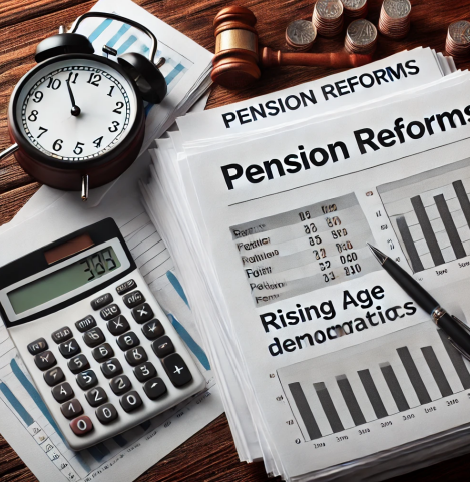Exploring the Impact of Demographic Changes on Retirement Planning and Pension Systems
The global population is undergoing a seismic shift. Birth rates are declining, life expectancy is rising, and the proportion of older adults is growing faster than ever. These demographic changes are reshaping retirement planning and straining traditional pension systems. For individuals aged 20–50—especially those with disposable income—understanding these trends is critical to securing financial stability in later life. This article explores how aging populations, workforce dynamics, and policy reforms are redefining retirement strategies and pension frameworks worldwide.

1. The Aging Population: A Global Phenomenon
The world is graying. By 2050, 1 in 6 people will be over 65, up from 1 in 11 in 2019, according to the United Nations. Countries like Japan, Italy, and Germany already have median ages above 45, while emerging economies such as China and Brazil are aging rapidly due to declining fertility rates and improved healthcare.
Why This Matters for Retirement Planning
- Longer Retirement Periods: A 65-year-old today can expect to live 20+ years in retirement, compared to 12–15 years in 1960.
- Pressure on Pension Systems: Fewer workers are supporting more retirees. For example, Japan’s worker-to-retiree ratio has dropped from 10:1 in 1950 to 2:1 today.
- Healthcare Costs: Longer lifespans increase the risk of chronic illnesses, with global healthcare spending projected to rise by 5% annually through 2030.

2. The Strain on Traditional Pension Systems
Most public pension systems operate on a pay-as-you-go (PAYG) model, where current workers fund retirees’ benefits. However, demographic shifts are exposing flaws in this structure:
Underfunded Systems: The U.S. Social Security Trust Fund is expected to be depleted by 2034 without reforms.
Low Interest Rates: Central banks’ policies since 2008 have reduced returns on pension fund investments.
Inequities: Younger generations may receive fewer benefits despite paying higher contributions.
Case Study: Sweden’s Notional Defined Contribution (NDC) System
Sweden reformed its pension system in the 1990s to link benefits to life expectancy and economic growth. This “auto-balancing” mechanism adjusts payouts based on demographic and fiscal realities—a model now being studied by other nations.
3. Rethinking Personal Retirement Strategies
With public pensions under pressure, individuals must take greater ownership of their retirement planning. Here’s how:
a. Diversify Income Streams
Invest in Tax-Advantaged Accounts: Maximize contributions to 401(k)s, IRAs, or Roth IRAs.
Explore Passive Income: Rental properties, dividend stocks, or royalties can supplement pensions.
Delay Retirement: Working until 67 instead of 62 can increase Social Security benefits by 30%.
b. Account for Longevity Risk
Annuities: These insurance products provide guaranteed income for life, hedging against outliving savings.
Health Savings Accounts (HSAs): Triple tax advantages make HSAs ideal for covering medical costs in retirement.
c. Leverage Technology
Robo-advisors like Betterment and Wealthfront offer low-cost portfolio management, while apps like Personal Capital track net worth and retirement readiness.

4. Policy Reforms Shaping the Future of Pensions
Governments and employers are adapting to demographic realities through innovative reforms:
Automatic Enrollment: Countries like the UK and New Zealand automatically enroll workers in workplace pensions, boosting participation rates.
Raising Retirement Ages: France increased its retirement age from 62 to 64 in 2023, despite protests.
Private Pension Innovations: Chile’s privatized system allows workers to choose between competing fund managers, though critics cite inequality risks.
The Rise of ESG Investing
Environmental, social, and governance (ESG) criteria are now integral to pension funds. BlackRock, for instance, mandates ESG disclosures for companies in its $10 trillion portfolio, aligning retirement savings with climate goals.
5. The Role of Financial Literacy in Bridging Gaps
A 2023 Global Financial Literacy Excellence Center study found that only 34% of adults worldwide understand basic financial concepts like compound interest. Improving literacy is key to empowering individuals to:
- Avoid high-fee investments.
- Recognize the impact of inflation on savings.
- Plan for healthcare and long-term care costs.
Employer Initiatives
Companies like Google and Microsoft offer financial wellness programs, including workshops on retirement planning and access to certified advisors.
Conclusion
Demographic changes are irreversible, but they don’t have to derail retirement security. By combining personal responsibility—diversifying income, leveraging technology, and planning for longevity—with systemic reforms like auto-enrollment and sustainable investing, individuals and societies can build resilient futures. For those aged 20–50, starting early and staying informed is the ultimate hedge against uncertainty.
(Writer:Lorik)





